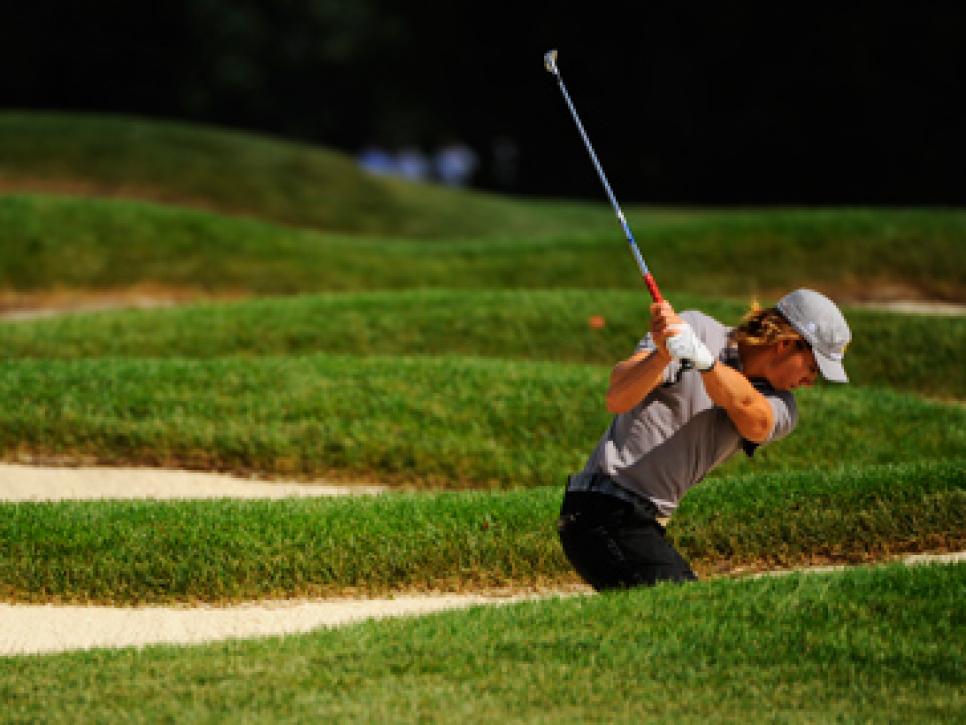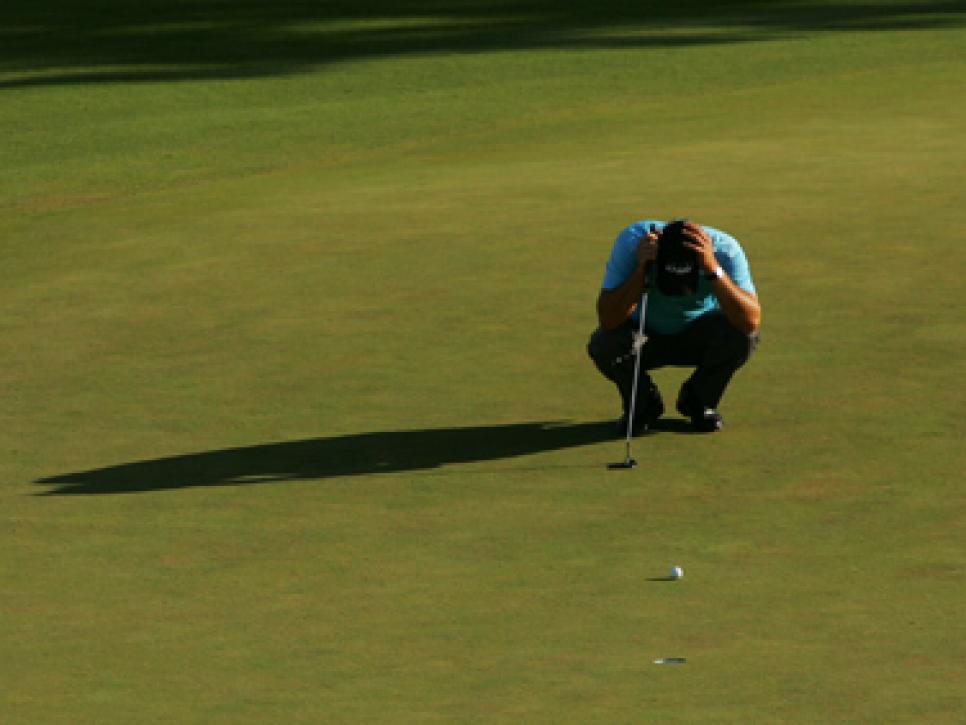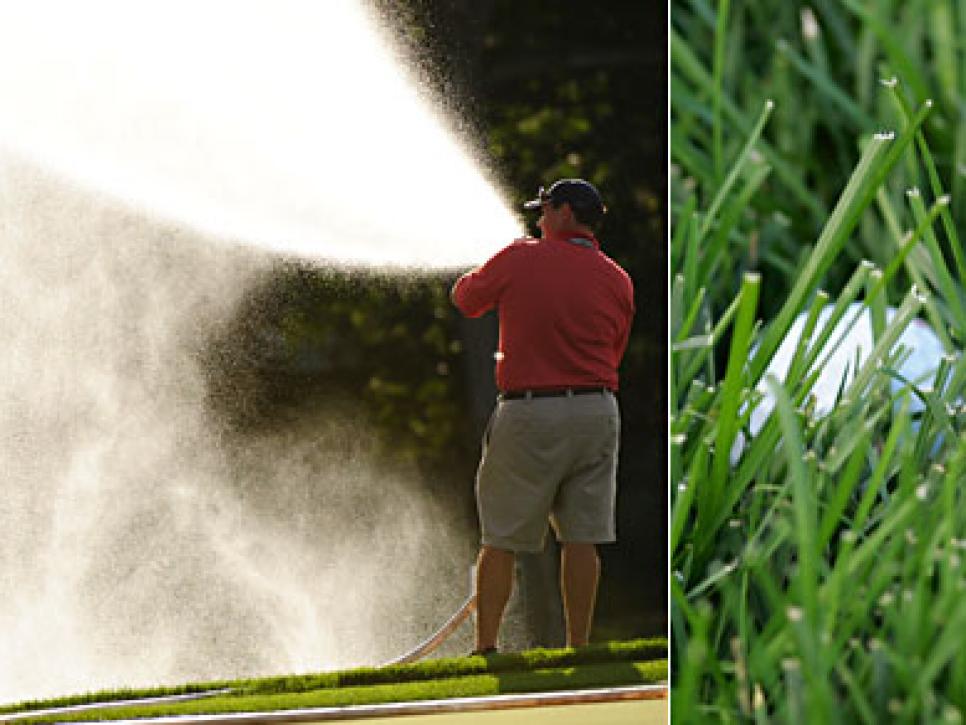News
Thoughts From Oakland Hills

Villegas kept stray shots to a minimum and rode solid putting to a share of fourth with Henrik Stenson.
Think, for a moment, of elite golf as a game of tug-of-war to decide bragging rights at recess. The players, equipped with the latest and greatest clubs, balls, swings and pre-shot routines money can buy, hold one end of the rope. The folks who control the golf courses where those players try to strut their stuff grasp the other end, armed with neutralizing agents--equally high-tech fertilizers, mowers and battle plans. Nobody wants to get rope burn. Nobody wants to end up on their backsides. Whether measured by scores or pride, nobody wants to lose, and this probably has been the case since golf balls were constructed of boiled goose feathers stuffed into leather pouches.
A basketball arena can have soft rims, a baseball park a short right-field fence, or a football stadium slippery turf, but the range of possible differences from one locale to the other is minimal. The basket is 10 feet high, bases are 90 feet apart and the football field is 100 yards long. The variables of golf's playing fields help make it the wonderful game it is.
This diversity--the scope of possibilities for where the action takes place--is not without consequences. Bobby Jones, Ben Hogan, Jack Nicklaus and Tiger Woods would have won championships playing in parking lots or through cornfields. But how easy should a course play? Or how hard?
Should the course be the star, or should the stars be the show? The questions have heated up this year, fueled in particular by the setups at the major championships: the Masters, where the modifications of Augusta National have made the course play more like a traditional U.S. Open, grind-it-out pars replacing flurries of birdies and eagles; the U.S. Open, now perceived to be tough, yes, but fairer thanks to graduated rough at Torrey Pines South; the British Open, where four days of very strong wind presented links golf on the edge at Royal Birkdale, yet it allowed creative shotmakers to survive, even thrive.
The major season concluded last week with the PGA Championship on the South course at Oakland Hills CC in Bloomfield Township, Mich., and the conversation about the nature of the proper stage for the world's best golfers continued. Padraig Harrington's victory over Sergio Garcia and Ben Curtis in a taut final round will be remembered for the Irishman's clutch shotmaking and sure putting--particularly the Woodsian, must-have putts he sank on the final three holes to secure his second consecutive major title and third in six starts--but the course also was front and center.
Oakland Hills is akin to a race course with a lot of hairpin turns that forever have a driver on alert. The layout's curves are in the form of the humped and rolling greens architect Donald Ross shaped in 1918. Like the stained-glass windows in an old church that has been repainted and re-roofed through the years, the greens remain as Oakland Hills' distinctive feature. "I've always said these are the most difficult greens in the country, if not the world," said Kerry Haigh, managing director of championships for the PGA of America, who was in charge of the course setup last week. "That fact, with the additional changes that were made, meant that it was going to be a very challenging and difficult course."
Those "additional changes" were carried out in 2006 by architect Rees Jones--with about 350 more yards, new and refashioned bunkers, an enlarged pond and reconfigured green on No. 16 among the biggest touches. It was a 21st century version of what Jones' father, Robert Trent Jones, had done at Oakland Hills before the 1951 U.S. Open, when he toughened the course into what came to be known as "The Monster" by adding length, creating/repositioning many fairway bunkers, and turning the eighth and 18th holes into taxing par 4s. Hogan won that Open at seven-over 287 by shooting a final-round 67, writing another boldfaced line for himself in golf lore. Trent Jones and Oakland Hills also made names for themselves, and major-as-survival test became a recurring theme in the sport, in no small part because of USGA executive director Joseph C. Dey Jr., for whom "protect par" was practically an 11th Commandment.

Rees Jones, whose first major-site redesign was played 20 years ago, when the U.S. Open was staged at The Country Club in Brookline, Mass., might not have gotten a chance to follow in his father's bulldozers if Oakland Hills hadn't been the scene of the 2002 U.S. Amateur. It had only been six years since Steve Jones won the 1996 U.S. Open on a 6,974-yard Monster at two-under 278 (edging Tom Lehman and Davis Love III, who botched the 72nd hole, Lehman with a bad drive, Love by three-putting), but the game had seen the arrival of thin-covered, solid-core golf balls and large-headed metal drivers with a trampoline effect.
The collegians in the 2002 Amateur tore up the South course in qualifying, averaging 71.5 strokes. Bill Haas, an All-American at Wake Forest at the time, drove it so far on the 462-yard 18th hole that he had a 9-iron to the green in his qualifying round, which he hit to four feet and made the birdie putt to be the medalist at five-under 135. Haas shot a front-nine 28 in his quarterfinal match, and Oakland Hills members and USGA officials--who said they had set up the course as a U.S. Open and believed 12- to 15-under would have won--were aghast. "It's very frustrating," Tom Meeks, then the USGA senior director of rules and competitions, told Golf World amid the birdie barrage. "All we can do is narrow the fairways and add fairway bunkers." The 2002 Amateur was to Oakland Hills what Phil Mickelson's driver-and-flip sand wedge to the 11th hole at Augusta National in 2001 was to Hootie Johnson--a clarion call to counteract equipment advances by making a course longer and meaner.
Some pros got a taste of the revamped South course last summer in a 36-hole qualifier for the British Open. J.B. Holmes, who would lead the PGA through 36 holes before melting down with a final-round 81, found out about the rigors of the touched-up 16th hole when he hit three balls in the water and made a 10, shooting a 79 and failing to qualify by seven shots. Architect Pete Dye, who spectated a couple of days during the PGA, said one Oakland Hills member told him his handicap had gone up seven strokes since Rees' revisions. "The Monster has its teeth back, and they're sharp," club general manager Rick Bayliss bragged to USA Today last week.
Rees Jones removed his blue cap with "The Monster" logo on the crown and sat down to talk in the media center late Friday afternoon, the 36-hole cut heading toward eight-over 148, with the leader, Holmes, at one-under 139. "I'm pleased, I think the members are pleased, and I think the players that are around par are pleased," Jones said. "Certain players play well in more difficult conditions. They have a better chance to win on a course that is really an examination."
The test Jones described had irritated many of the players. If it wasn't the baked-out greens, it was the fluffed-up three- to four-inch-thick rough, actually raked from green to tee so it would stand up uniformly. The examination was turning into a walk over hot coals. "What Oakland Hills is doing, because the green complexes are so challenging, is putting the driver in their hands because they have to get as close to the green [as they can] to access the hole location," Jones said. "They know if they lay up off the tee and they have a 40-foot putt, there is a good chance they are going to three-putt. It's putting a little more pressure on them off the tee. The fairways are probably averaging 25 or 26 yards wide. For the Ryder Cup [in 2004], they averaged 32 yards wide. They're trying to reward accuracy and take away the bombers' advantage."

Jones contended Oakland Hills has an "ebb and flow" of conquerable holes and difficult ones, but all the putting surfaces got parched Thursday and Friday in the dry, windy conditions. "We had rain forecast for Tuesday, Wednesday and Thursday, which kept skirting us," Haigh said. "The greens were 11½ to 12 [on the Stimpmeter] in the morning. They were actually slower than they were in the [2004] Ryder Cup. The winds and the dry air are what [affected them]. We syringed the greens and put a little bit [of water] on, and the aim was to make the course play similar both days, as it always is. You don't want to go too far the other way [watering the greens]. It's always a bit of a dicey game. Once everyone has had a morning and afternoon tee time, you can make an adjustment, which is more reasonable and fair than between Thursday and Friday."
Haigh has received many compliments during his tenure about how fair his setups are, but last week the critiques were not all so friendly. "You try and do what you think is right, and sometimes it doesn't always work out," he said Sunday evening. "It's not through lack of trying or the aim of how you wanted it to play. Mother Nature usually has an effect on that."
Mother Nature tinged some greens, notably the surfaces at the long par-3 ninth and 17th holes. "I looked at the ninth green before they started syringing it Friday, and I saw a lot of earth tones," said XM Radio announcer Larry Rinker, a former tour player.
"The PGA usually gets it right," said 1993 PGA champion Paul Azinger, who made the cut on the number. "I think they do the best setup of all the majors. I don't think it is unfair. I just think it's really, really hard. But there are some unfair situations you can get in, for sure." Harrington said that the rough was the old-style U.S. Open variety, all of one height. "This course is set up more like a U.S. Open course was three or four years ago, where missing the fairway by a couple of yards is the same as missing it by 10 yards," he said. "It's a more intimidating test and more punishing, in the sense that a slight miss is just as bad as a big miss."
If you look at the numbers, the carnage wasn't as great as the carping. In the 1951 U.S. Open the field averaged 75.2 in the final round and 77.2 for the week; last week's scores averaged 73.438 for the final round and 74.3 for four rounds. Compared to the 1996 Open, the most recent professional major at Oakland Hills and last before the changes, the PGA had the same number of players under par (three) but the cumulative stroke average was almost a shot higher than the 73.6 total in '96. (There was also a gullywasher the day before the '96 Open started, softening the greens even more than last Saturday's rain moistened them.) The "cost of rough," which many in the game believe should be about half a stroke, was in fact a bit less than that for the week at 0.396 of a shot.
"Remember one thing," Jones said, "you can't keep everybody happy. Even in your family, you can't keep everybody happy. Somebody told me this week: 'Rees, you can't win. If it's too hard, the players are going to complain; if it's too easy, the members are going to complain.' So maybe right around par, and I'm OK." Jones says he feels "more obligated to the game itself," to maintain a challenge he believes is elemental to it. "We've been trying to get them to hit some medium to long irons into some holes. We're trying to bring back the ebb and flow, the fact that this is a very difficult game. You and I have a hard time out there [playing]. I think the fans actually like to see the best players in the game do well for a couple of holes, then have the same problems we have and have to make decisions."

"He'd be very pleased," Rees said, when asked what he believed his late father would think of his son's work at Oakland Hills and how the course played last week. "Nobody knows what a swizzle stick is anymore. But my Dad used to say the pros want to play every hole with a driver and a swizzle stick. I guess they're not doing that this week."
Given the chance, though, the players are the ones who stir the drink. They are the protagonists, and it is worth noting that one of the most dramatic moments in the final round wouldn't have happened had the greens remained as uninviting as they were the first two days. Harrington's glorious 5-iron to 10 feet at the 17th hole, followed by an even better one by Garcia moments later, came on a hole that just 25 percent of the field reached in regulation during the first 36 holes.
"I looked at 17 at the start of the week, and we knew the pin would be back-right on the last day," Harrington said. "When the green was firm, we decided that the play was to the front of the green and putt up over the tier. But with a little softness in the green, we knew we could take it on and hit a nice shot straight down [on] the pin. If it was firm as it was on Thursday and Friday, if they put the pin back there, it would be close to a lottery to get it on the right level."
Curtis, playing in the final group and one shot behind Harrington when he got to No. 17, had the same opportunity. His tee shot, with a 4-iron, looked good, but it landed just past the flagstick and bounded over the green into a horrendous lie. "I hit the shot a little thin, and that's why it bounced through the green," Curtis admitted afterward, placing the blame squarely on himself and not on the putting surface that had rejected more shots than a 7-foot-7 center when it was in its blue period Thursday and Friday. "I had a tough lie over the green and just didn't get it up and down."
Speaking from the comfort of the champion's seat, of being only the fourth golfer to win the British Open and the PGA Championship in the same year, Harrington affirmed how the course had played. "I think we got the ideal setup this week," he said. "We got two days of really tough golf, a hard and fast golf course. That's kind of what golf is meant to be like. It's meant to be bouncy [with] good and bad breaks, [difficulty] judging distances. That's what traditional golf is like. Then, when it rained, it softened up the course, and I think the fans got what they wanted: excitement. There were plenty of birdies to be made, and the golf course still was tough."
Indeed, only nine players broke par in the last round. It was hardly a pushover, yet birdies were possible. Even with the dense rough, the beefed-up par 4s and a cool, substantial breeze that made it feel like fall, Oakland Hills' severe greens were slowed and softened enough to let the play--not the stage--be the thing.
"On these type of greens, I think you should be able to control your spin, where it would take a hop and go 10 or 12 feet forward and then stop," Curtis said. "The British Open is a good test, but their greens are flat. You can run it up from 50 yards short, or you can fly it to the front edge and try to spin it. It was almost too hard [here], especially Thursday. We saw a ball bounce on No. 14 in the group behind us. They couldn't have been hitting more than a wedge from the fairway. That ball hit the front of the green and went over the back. That's not right."
Happily, that type of thing wasn't happening over the weekend. Even at a layout as difficult as Oakland Hills, there ought to be a happy medium. Maybe, as Haigh contends, the dry air, bright sun, steady wind and erroneous forecast were mostly to blame for the conditions the first two rounds. Some water wisely was put on the course before the third round, before the rains that hit Saturday afternoon. Andres Romero shot a 65, but the PGA Championship didn't turn into the Wichita Open. A great course got a great champion from a great conclusion, but the week wouldn't have been diminished had the cut come at four over, or if the winning score had been nine under, or if a dozen players had finished under par for 72 holes, or if, heaven forbid, the greens, perhaps the most severe in America, were running a couple of feet slower on the Stimpmeter. "I bet there wasn't a course anywhere in the country that had greens rolling at more than 6 in 1951," Pete Dye said last week, reiterating something he often points out about the evolution of playing conditions.
It sure was more fun to watch Harrington and Garcia stuff their tee shots tight on No. 17 Sunday than to see Vijay Singh putt his ball off the ninth green Friday afternoon. Tour pros can be crybabies from time to time when it comes to how they earn their living, but once in a while their tears are justified.